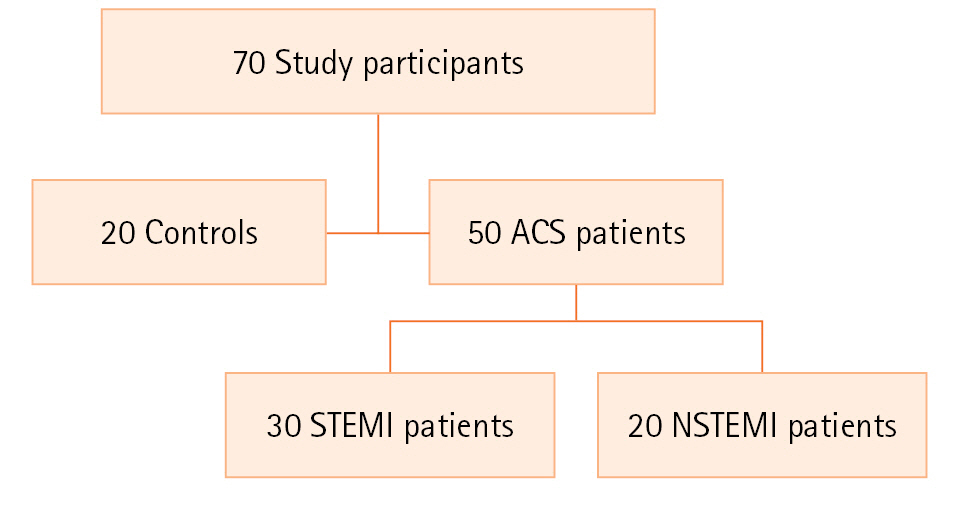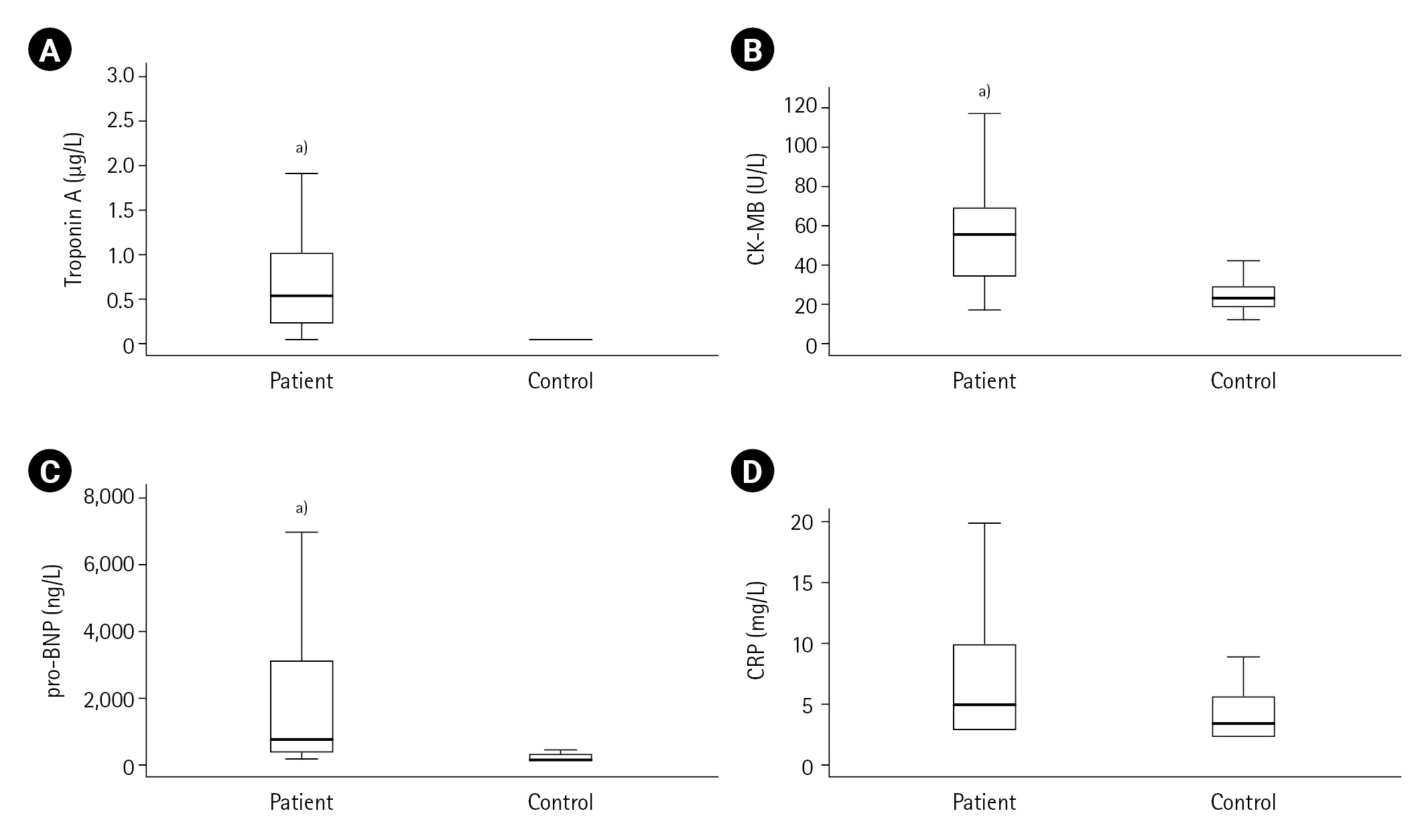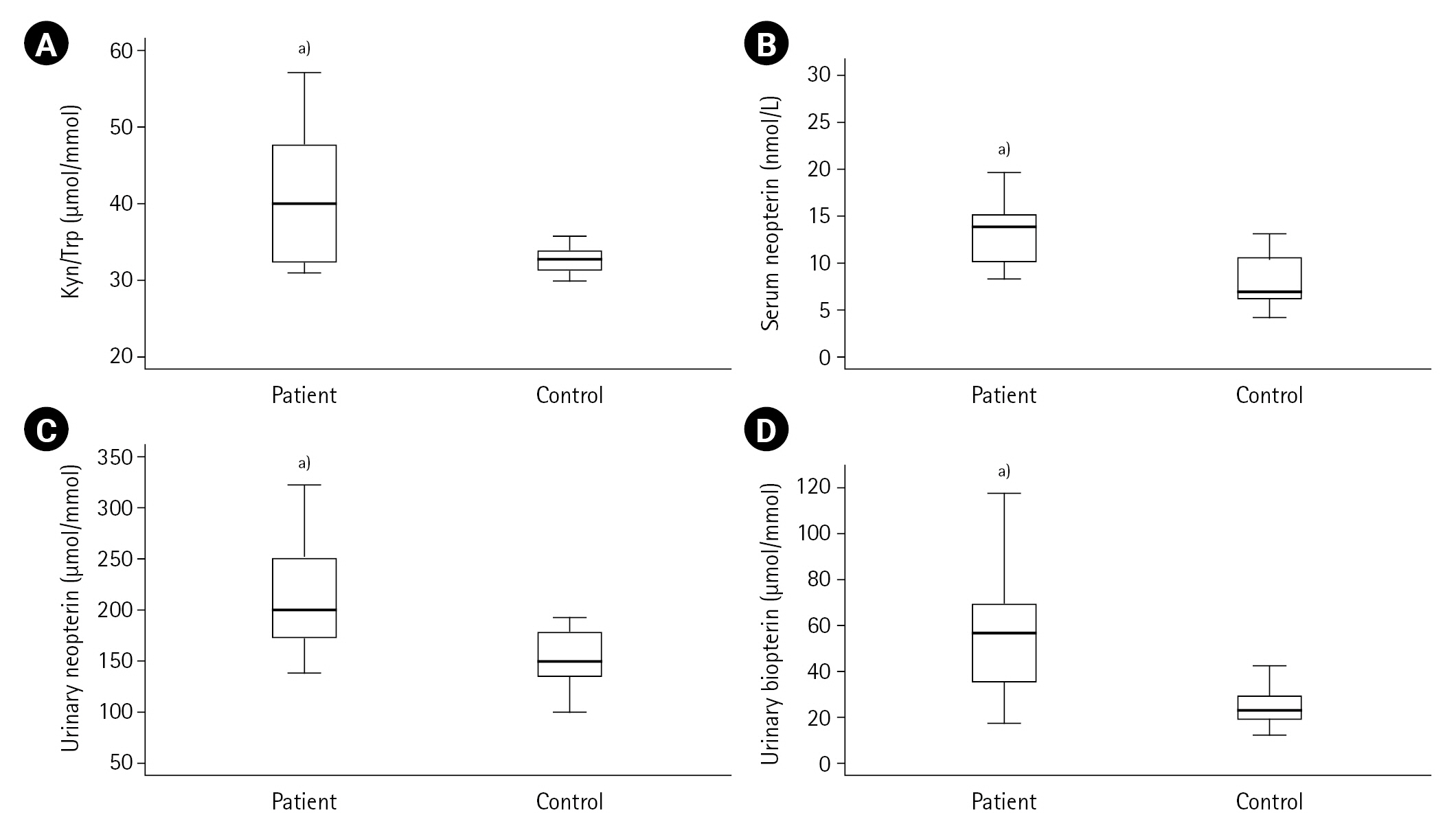Acute Crit Care.
2023 Aug;38(3):325-332. 10.4266/acc.2023.00024.
Evaluation of neopterin levels and kynurenine pathway in patients with acute coronary syndrome
- Affiliations
-
- 1Department of Toxicology, Faculty of Pharmacy, Hacettepe University, Ankara, Türkiye
- 2Department of Emergency Medicine, Tuzla Devlet Hastanesi, Istanbul, Türkiye
- KMID: 2547026
- DOI: http://doi.org/10.4266/acc.2023.00024
Abstract
- Background
Coronary atherosclerosis is the leading cause of coronary artery disease. Several investigations have indicated that tear-sensitive plaques contain macrophages and T cells. Neopterin is an essential cellular immune response biomarker. The main goal of this study was to see if there were any changes in biomarkers like unconjugated pteridines, neopterin, and biopterin, as well as kynurenine pathway enzymes like indoleamine 2,3-dioxygenase (IDO), which catalyzes the rate-limiting step in tryptophan degradation, in patients with the acute coronary syndrome (ACS) caused by angiographic atherosclerosis.
Methods
High-performance liquid chromatography was used to determine the amounts of neopterin, biopterin, and creatinine in urine samples, as well as tryptophan and kynurenine in serum samples. The enzyme-linked immunosorbent assay was used to assess the amounts of neopterin in serum samples. The measured parameters were evaluated between ACS patients and controls.
Results
The measured levels of neopterin, biopterin and the kynurenine to tryptophan ratio reflecting IDO activity, and the specifically known biomarkers such as cardiac troponin, creatine kinase, myoglobin, and natriuretic peptides are statistically higher in ACS patients compared to control subjects. On the other hand, the measured parameters are inadequate to classify the conventional kinds of ACS, ST-elevation- and non-ST-elevation- myocardial infarction.
Conclusions
The study found that determining and using neopterin and IDO parameters as biomarkers in individuals with the ACS can support traditional biomarkers. However, it can be concluded that evaluating pteridine biomarkers solely have no privilege to clinical findings in ACS diagnosis and classification.
Keyword
Figure
Reference
-
1. Brown RM. Acute coronary syndrome in women. Emerg Med Clin North Am. 2022; 40:629–36.
Article2. Atwood J. Management of acute coronary syndrome. Emerg Med Clin North Am. 2022; 40:693–706.
Article3. Simons M, Alpert JS. Acute coronary syndrome: terminology and classification [Internet]. UpToDate;2022. [cited 2023 Jul 20]. Available from: https://www.uptodate.com/contents/acute-coronary-syndrome-terminology-and-classification.4. Pacileo M, Cirillo P, De Rosa S, Ucci G, Petrillo G, Musto D’Amore S, et al. The role of neopterin in cardiovascular disease. Monaldi Arch Chest Dis. 2007; 68:68–73.
Article5. Ünüvar S, Erge D, Kılıçarslan B, Gözükara Bağ HG, Çatal F, Girgin G, et al. Neopterin levels and indoleamine 2,3-dioxygenase activity as biomarkers of immune system activation and childhood allergic diseases. Ann Lab Med. 2019; 39:284–90.
Article6. Cavaleri D, Bartoli F, Capogrosso CA, Guzzi P, Moretti F, Riboldi I, et al. Blood concentrations of neopterin and biopterin in subjects with depression: a systematic review and meta-analysis. Prog Neuropsychopharmacol Biol Psychiatry. 2023; 120:110633.
Article7. Hoekstra R, van den Broek WW, Fekkes D, Bruijn JA, Mulder PG, Pepplinkhuizen L. Effect of electroconvulsive therapy on biopterin and large neutral amino acids in severe, medication-resistant depression. Psychiatry Res. 2001; 103:115–23.
Article8. Sabuncuoğlu S, Öztaş Y, Yalcinkaya A, Ünal S, Baydar T, Girgin G. The increased neopterin content in Turkish pediatric patients with sickle cell anemia. Ann Hematol. 2020; 99:41–7.
Article9. Gürcü S, Girgin G, Yorulmaz G, Kılıçarslan B, Efe B, Baydar T. Neopterin and biopterin levels and tryptophan degradation in patients with diabetes. Sci Rep. 2020; 10:17025.
Article10. Ozkan Y, Sukuroglu MK, Tulmac M, Kisa U, Simsek B. Relation of kynurenine/tryptophan with immune and inflammatory markers in coronary artery disease. Clin Lab. 2014; 60:391–6.
Article11. Swardfager W, Herrmann N, Dowlati Y, Oh PI, Kiss A, Walker SE, et al. Indoleamine 2,3-dioxygenase activation and depressive symptoms in patients with coronary artery disease. Psychoneuroendocrinology. 2009; 34:1560–6.
Article12. Wirleitner B, Rudzite V, Neurauter G, Murr C, Kalnins U, Erglis A, et al. Immune activation and degradation of tryptophan in coronary heart disease. Eur J Clin Invest. 2003; 33:550–4.
Article13. Moe KT, Wong P. Current trends in diagnostic biomarkers of acute coronary syndrome. Ann Acad Med Singap. 2010; 39:210–5.
Article14. Girgin G, Sahin TT, Fuchs D, Yuksel O, Kurukahvecioglu O, Sare M, et al. Tryptophan degradation and serum neopterin concentrations in intensive care unit patients. Toxicol Mech Methods. 2011; 21:231–5.
Article15. Widner B, Werner ER, Schennach H, Wachter H, Fuchs D. Simultaneous measurement of serum tryptophan and kynurenine by HPLC. Clin Chem. 1997; 43:2424–6.
Article16. Matsushita K, Yatsuya H, Tamakoshi K. Epidemiology of acute coronary syndrome. Nihon Rinsho. 2006; 64:625–32.17. van Haelst PL, Liem A, van Boven AJ, Veeger NJ, van Veldhuisen DJ, Tervaert JW, et al. Usefulness of elevated neopterin and C-reactive protein levels in predicting cardiovascular events in patients with non-Q-wave myocardial infarction. Am J Cardiol. 2003; 92:1201–3.
Article18. Kaski JC, Consuegra-Sanchez L, Fernandez-Berges DJ, Cruz-Fernandez JM, Garcia-Moll X, Marrugat J, et al. Elevated serum neopterin levels and adverse cardiac events at 6 months follow-up in Mediterranean patients with non-ST-segment elevation acute coronary syndrome. Atherosclerosis. 2008; 201:176–83.
Article19. Dominguez-Rodriguez A, Abreu-Gonzalez P, Garcia-Gonzalez M. Usefulness of neopterin levels and left ventricular function for risk assessment in survivors of acute myocardial infarction. Int J Cardiol. 2006; 111:318–20.
Article20. Gurumurthy P, Borra SK, Yeruva RK, Babu S, Thomas J, Cherian KM. Estimation of serum neopterin in patients with acute coronary syndrome. Asian Cardiovasc Thorac Ann. 2013; 21:426–31.
Article21. Zouridakis E, Avanzas P, Arroyo-Espliguero R, Fredericks S, Kaski JC. Markers of inflammation and rapid coronary artery disease progression in patients with stable angina pectoris. Circulation. 2004; 110:1747–53.
Article22. Garcia-Moll X, Coccolo F, Cole D, Kaski JC. Serum neopterin and complex stenosis morphology in patients with unstable angina. J Am Coll Cardiol. 2000; 35:956–62.
Article23. Avanzas P, Arroyo-Espliguero R, Quiles J, Roy D, Kaski JC. Elevated serum neopterin predicts future adverse cardiac events in patients with chronic stable angina pectoris. Eur Heart J. 2005; 26:457–63.
Article24. Avanzas P, Arroyo-Espliguero R, Cosin-Sales J, Quiles J, Zouridakis E, Kaski JC. Prognostic value of neopterin levels in treated patients with hypertension and chest pain but without obstructive coronary artery disease. Am J Cardiol. 2004; 93:627–9.
Article25. Tanaka T, Nakamura Y, Nasuno A, Mezaki T, Higuchi K, Fukunaga H, et al. Plasma concentrations of monocyte chemoattractant protein 1 (MCP-1) and neopterin in the coronary circulation of patients with coronary artery disease. Circ J. 2004; 68:114–20.
Article26. Schumacher M, Halwachs G, Tatzber F, Fruhwald FM, Zweiker R, Watzinger N, et al. Increased neopterin in patients with chronic and acute coronary syndromes. J Am Coll Cardiol. 1997; 30:703–7.
Article27. Nazer B, Ray KK, Sloan S, Scirica B, Morrow DA, Cannon CP, et al. Prognostic utility of neopterin and risk of heart failure hospitalization after an acute coronary syndrome. Eur Heart J. 2011; 32:1390–7.
Article28. Murr C, Grammer TB, Kleber ME, Meinitzer A, März W, Fuchs D. Low serum tryptophan predicts higher mortality in cardiovascular disease. Eur J Clin Invest. 2015; 45:247–54.
Article29. Ray KK, Morrow DA, Sabatine MS, Shui A, Rifai N, Cannon CP, et al. Long-term prognostic value of neopterin: a novel marker of monocyte activation in patients with acute coronary syndrome. Circulation. 2007; 115:3071–8.30. Pedersen ER, Svingen GF, Schartum-Hansen H, Ueland PM, Ebbing M, Nordrehaug JE, et al. Urinary excretion of kynurenine and tryptophan, cardiovascular events, and mortality after elective coronary angiography. Eur Heart J. 2013; 34:2689–96.
Article
- Full Text Links
- Actions
-
Cited
- CITED
-
- Close
- Share
- Similar articles
-
- Neopterin Levels and Indoleamine 2,3-Dioxygenase Activity as Biomarkers of Immune System Activation and Childhood Allergic Diseases
- Serum Neopterin Concentration in Children with Graves' Disease
- The Clinical Significance of Serum and Urinary Neopterin Levels in Several Renal Diseases
- Elevated Serum Levels of Neopterin in Patients with Behçet's Disease
- Levels of Urinary Neopterin in Patients with Lepromatous Leprosy and Patients with Erythema Nodosum Leprosum




